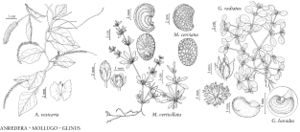Herbs [shrubs], annual or perennial, glabrous or pubescent, not or slightly succulent. Leaves alternate, opposite, or whorled, petiolate [or sessile]; blade margins entire; stipules present or absent. Inflorescences axillary or terminal, cymose or umbellate, or flowers solitary. Flowers usually bisexual, sessile or pedicellate. Perianth hypogynous; sepals 4–5, distinct to basally connate; petals absent, or small and of staminodial origin, distinct or basally connate; stamens 2–25, hypogynous, in 1–2 series, sometimes fascicled, distinct or basally connate; filaments filiform; anthers versatile, 4-locular, dehiscence introrse, longitudinal; pollen 3-aperturate; pistils of 1–5 connate carpels; placentation axile or appearing basal in some 1-ovulate carpels; ovules 1–25 per locule; stigmas 1 or 3–5, apical, sessile or borne on styles. Fruits achenes or 3–5-valved loculicidal capsules. Seeds reniform to lenticular, sometimes strophiolate (with hilar appendages); endosperm lacking, starch present; embryo curved.
Distribution
North America, West Indies, Central America, South America, Europe, Asia, Africa, Australia.
Discussion
Genera 14, species 125 (2 genera, 4 species in the flora).
Molluginaceae are not of great economic importance. Several species of Glinus and Mollugo are weedy, and occasionally some have been used medicinally or as vegetables (A. L. Bogle 1970b; M. E. Endress and V. Bittrich 1993).
The taxonomic placement of genera of Molluginaceae has been problematic, and they have been considered members of the Aizoaceae, Nyctaginaceae, or Phytolaccaceae. Based on phylogenetic lineages derived from rbcL gene sequences, M. W. Chase et al. (1993) showed that Molluginaceae are distinct from Aizoaceae and a sister group to Nyctaginaceae and Phytolaccaceae. Neither Chase et al. nor J. E. Rodman et al. (1984) found evidence supporting a basal position of Molluginaceae relative to the rest of Centrospermae.
